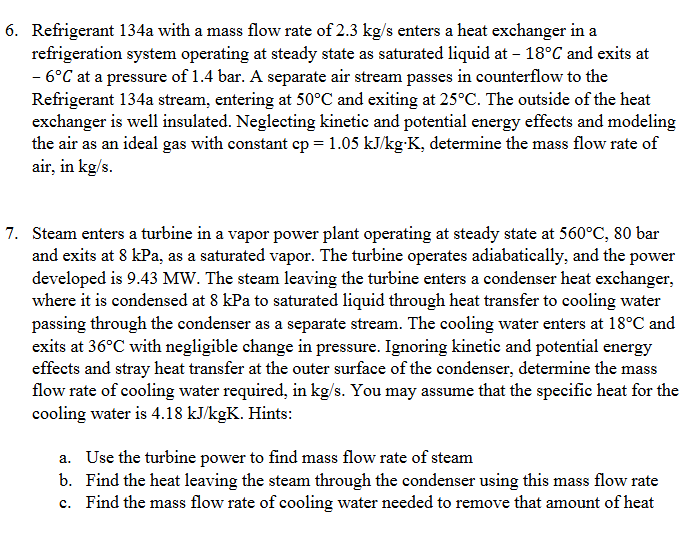(Solved): 6. Refrigerant 134a with a mass flow rate of \( 2.3 \mathrm{~kg} / \mathrm{s} \) enters a heat excha ...
6. Refrigerant 134a with a mass flow rate of \( 2.3 \mathrm{~kg} / \mathrm{s} \) enters a heat exchanger in a refrigeration system operating at steady state as saturated liquid at \( -18^{\circ} \mathrm{C} \) and exits at \( -6^{\circ} \mathrm{C} \) at a pressure of 1.4 bar . A separate air stream passes in counterflow to the Refrigerant 134 a stream, entering at \( 50^{\circ} \mathrm{C} \) and exiting at \( 25^{\circ} \mathrm{C} \). The outside of the heat exchanger is well insulated. Neglecting kinetic and potential energy effects and modeling the air as an ideal gas with constant \( \mathrm{cp}=1.05 \mathrm{~kJ} / \mathrm{kg} \cdot \mathrm{K} \), determine the mass flow rate of air, in \( \mathrm{kg} / \mathrm{s} \). 7. Steam enters a turbine in a vapor power plant operating at steady state at \( 560^{\circ} \mathrm{C}, 80 \) bar and exits at 8 kPa , as a saturated vapor. The turbine operates adiabatically, and the power developed is 9.43 MW . The steam leaving the turbine enters a condenser heat exchanger, where it is condensed at 8 kPa to saturated liquid through heat transfer to cooling water passing through the condenser as a separate stream. The cooling water enters at \( 18^{\circ} \mathrm{C} \) and exits at \( 36^{\circ} \mathrm{C} \) with negligible change in pressure. Ignoring kinetic and potential energy effects and stray heat transfer at the outer surface of the condenser, determine the mass flow rate of cooling water required, in \( \mathrm{kg} / \mathrm{s} \). You may assume that the specific heat for the cooling water is \( 4.18 \mathrm{~kJ} / \mathrm{kgK} \). Hints: a. Use the turbine power to find mass flow rate of steam b. Find the heat leaving the steam through the condenser using this mass flow rate c. Find the mass flow rate of cooling water needed to remove that amount of heat Please help me solve these, showing all work for each.
